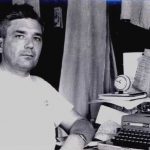 About the author: Herman Knight Beaber (May 25, 1907 — February 5, 2001), missionary, social worker, businessman.
About the author: Herman Knight Beaber (May 25, 1907 — February 5, 2001), missionary, social worker, businessman.
From the biography written by his son as an endnote for the published diary:
Born in Hydesville, California, May 25,1907. Attended college for 2 yrs. at the University of California, he studied chemistry and electrical engineering. Left college and went in the ministry in 1929. In 1940 he went to the Philippines with Leo Stancliff for missionary work. Attended 2 semesters at the University of the Philippines – foreign language studies. In 1941 war broke out with Japan, spent 3 years as POW. Returned to the U.S. in 1946. He later returned to Philippine Islands with Leo and his sister Bernice to continue missionary work in 1947. Due to health reasons he left the work in 1951. He then moved to Texas. He worked as a Counselor in a county home for children and later as an Assistant Superintendent and Manager of a Boy’s Home near Houston, Texas. He later married Mattie Blanche Berry in 1955 and moved to Dallas, Texas. There he worked as a Manager for Earl Hayes Truck Rental. In the early 1960’s he adopted two children. A girl he named Esther and later a boy he named John. He retired in the 1970’s. His beloved wife Blanche (Oct. 23.1998) preceded him in death. He has 7 grandchildren and 3 great grandchildren. He passed away at age 93 on Feb. 5, 2001.
About the diary: Published as Deliverance! It has Come!: In The Philippines 1942-1945. The book was posted in The Portal to Texas History, a digital repository hosted by the UNT Libraries.
The manuscript was composed of two different versions of the diary, a condensed one, and the full diary, as transcribed.
The story of the condensed version is told by Billy E. Karlinsey:
The following diary came into my possession when my
mother, Gazel Karlinsey died. I remember being impressed at that time while helping my mother copy the diary on an old typewriter. This was in the summer of 1951, while home on leave from the Navy.
In those days we did not have Xerox copy machines, so retyping with three to five carbons made copies. The number of carbon copies depended on how good your typewriter was and how strong your fingers were. I say all this because the copy that I work from could be the first or fortieth copy and from the way it looks it was the latter. So to this end to help, I used a personal computer with a Word Processor program that I used to type out a draft of this diary.
I was able to solicit the help of Mr. Rojo of Oak Harbor, a
Filipino friend of mine. He was born, 1939, in Cavite and raised there during the war years. He is responsible for catching all misspellings and misuse of the Filipino names and places that Rene and I miss out of ignorance. His price is a copy of the diary to send to his father, in the Philippines, who is in his late eighties. Mr. Rojo is sure his father will be just as fascinated in reading the diary as I was. I feel this a
blessed diary.
The story of the full diary and its being used to flesh out the condensed one, is told by the author’s son, John S. Beaber:
In January of 2001, I contacted Mr. Karlinsey and I asked him to send me a copy of his work. Mr. Karlinsey promptly replied and sent me Dad’s diary via e-mail. After vigilantly proofreading it against a copy that my Aunt Bernice had typed in 1966, I discovered that Mr. Karlinsey’s copy was a condensed version of the original. Since that time I have added all the missing parts and have come up with an entire version.